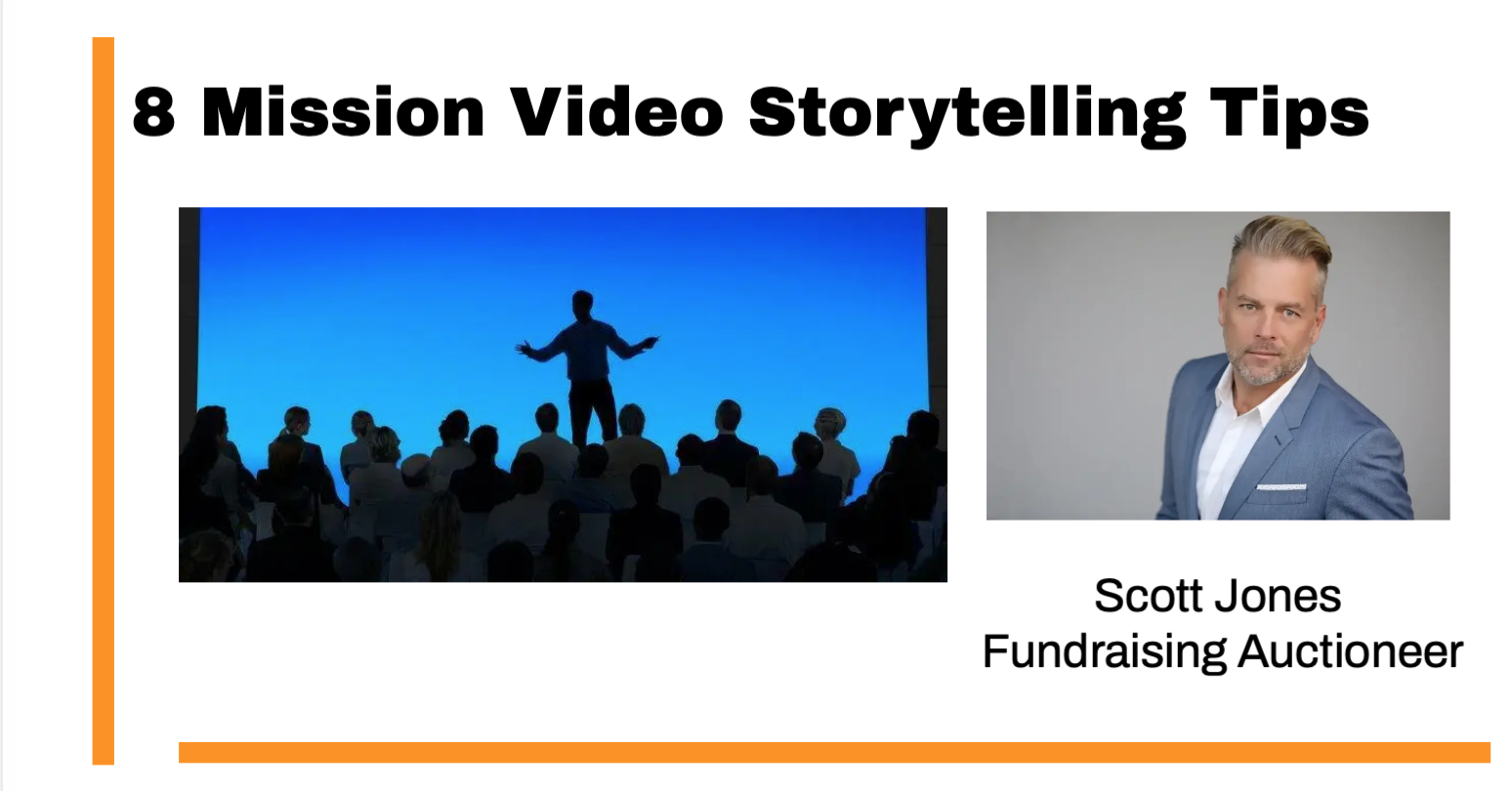8 Mission Video Storytelling Tips
By: Scott Jones
As the famous saying goes, stories make the world go round. They help non-profits build personal
connections, based on empathy, trust, and compassion with their supporters through the act of
storytelling. People process visuals 60,000 times better than text, which makes storytelling quite
important these days. Therefore, non-profits might want to invest more resources in sharing compelling
stories through video as a more effective means in connecting with donors.
Here are 8 key video storytelling techniques to help you create effective videos and connect with your
donor audience on a more personal level. Remember Donor Centric fundraising emphasizes to focus on
the values, passions and motivations of our donors.
1. Design a Strong Narrative Arc
Regardless of mission and the purpose, modern stories follow a similar progression. This progression is
also known as the narrative arc. The idea of the narrative arc is that every story has a calm beginning,
middle, where the momentum and emotions build-up, and an end. This is a classic narrative structure
we all are familiar with, which is also known as a hero’s journey. The classic narrative arc specifically in
stories filled with mission makes it easy for donors to follow along with the story, engages them, and
keeps them watching till the end.
2. Keep Your Target Audience in Mind
Fundraising consultants know that the very first step of every campaign is defining the target audience.
No matter what fund development you are pursuing, you need to know who your donor audience is.
Invest time to understand who your supporters are, their interests, their passions and what are their
motivations. You can then use this knowledge to build your narrative around the “emotions” of your
audience. This will encourage them to engage with your mission videos and watch them closely in
hopes that the story will inspire them to participate in fueling your fundraising through the act of giving.
3. Consider The Four P’s of Storytelling
Before you start working on your video, make sure you have a firm understanding of the four P’s of
storytelling: Plot, Purpose, People, Place.
1.) Plot: What is the story that you are telling in your video?
2.) Purpose: What is the aim of your story? Think about what you want to achieve with it and what
you want the donors to do.
3.) People: Who are the characters of your story, are the preferred individuals directly connected
with your mission or are they associates of the organization, and what is their role in the story
that you are trying to tell?
4.) Place: The location and background influence the story. What is the setting that you want your
story to take place in, and how will it affect the plot?
4. Appeal to Donor Emotions
One of the biggest reasons stories are so effective and resonate with us is because they convey
emotions. To make your story appealing to your donors, when you start to develop your video idea,
focus on the feelings you want to convey. To do it, you need to focus on other critical elements of video
storytelling. The colors, composition, plot, story development, and background music come together to
communicate an emotion effectively. Choose one emotion you want to evoke (be it sadness, warmth,
happiness, or hope), and share it for the whole duration of your video. The aim of the video is to
emphasize the importance of your mission, but at the same time, it also shares with us a beautifully
compelling story with an uplifting ending.
5. Forget About the Words
“Show, don’t tell” is an approach that has proven to be very affective in video storytelling. Add to that
the fact that over half of video content on social media is watched on mobile devices with the sound off,
and it becomes clear why it is important to master the visual elements of your story. Luckily, you don’t
need words to tell your story. What you need are engaging visuals that emphasize the context of your
message. The donors need to be able to understand what is happening in the video with the sound off.
If you can accomplish this task, imagine how the donors will react with the sound on!
6. Make Use of The Colors
Another way to communicate with your donor audience can be with colors. The correct choice of colors
have the power to make videos more appealing, create the perfect mood, and share your message with
the viewers. Once you understand the emotions you want to evoke, you can then understand the
feelings each color evokes. This method is also known as color psychology and is used by some of the
major brands around the world. In movies or videos, the color sets the tone of the story, even if the
actors don’t say a word. For example, the color orange evokes feelings of happiness, sociability, and
youthfulness.
7. Pay Attention to The Composition
As our attention spans continue to shorten and the amount of information we receive grows, you need
to compose videos so they would make it clear for the donors where they need to focus. Structure the
video in a way that your donor audience knows where the key elements of your story are and
concentrate on them
8. Make It Short and Sweet
Everyone has heard me say you can bring an audience to laughter or tears in 30 seconds or less. Just
watch the Super Bowl ads. If Instagram stories or TikTok has taught us anything, it’s that you don’t need
hours to tell a compelling story. So, when working on your video story, try to make it as short and clear
as possible. This is true, especially for the video stories you create for dedicated giving moments.
According to the research by BuzzSumo, that most donors prefer watching videos that are 2-4 minutes
long. If you can say something in 10 seconds, don’t take a minute to do it.
Every non-profit has a story. Next time when you are planning to share yours through video, consider
these storytelling basics. Whether you are creating a storyboard, writing a script, or are making a video,
these tips will give you fresh ideas, guide you through the process, and lead to creating a more
compelling visual story for your donor audience. Engage your donorswith exciting video content—and
you’ll steal the way to their minds and hearts.






